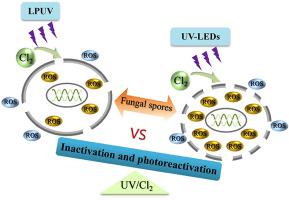Water Research ( IF 12.8 ) Pub Date : 2020-07-12 , DOI: 10.1016/j.watres.2020.116143 Qiqi Wan 1 , Gang Wen 1 , Ruihua Cao 1 , Hui Zhao 1 , Xiangqian Xu 1 , Yuancheng Xia 1 , Gehui Wu 1 , Wei Lin 1 , Jingyi Wang 1 , Tinglin Huang 1

|
Waterborne fungi have been recognized as an emerging environmental contaminant in recent years. This work was to investigate the inactivation efficiency and mechanisms of ultraviolet light-emitting diodes (UV-LEDs)/chlorine (Cl2) (265, 280 and 265/280 nm combination) and LPUV/Cl2 (254 nm) treatments for three fungal species compared with individual disinfection processes. Control of photoreactivation for fungal species inactivated by UV-LEDs/Cl2 and LPUV/Cl2 was also evaluated. The results revealed that the combined UV-LEDs/Cl2 and LPUV/Cl2 processes, especially UV-LEDs/Cl2, exhibited better inactivation performance compared to UV alone and Cl2 alone based on the inactivation rate constants, and an evident synergistic effect was observed. For example, the inactivation rates for Penicillium polonicum in the processes of UV265/Cl2, UV280/Cl2, UV265/280/Cl2 and LPUV/Cl2 was 0.142, 0.168, 0.174 and 0.106 cm2/mJ, respectively, which were all approximately 1.5-fold higher than that of UV alone. The synergistic effect of fungal spores inactivation by UV-LEDs/Cl2 and LPUV/Cl2 was due to the high level production of intracellular reactive oxygen species and the reaction of potential extracellular free radicals. Resistance of the tested fungal spores was as follows: Trichoderma harzianum < Penicillium polonicum < Aspergillus niger. In addition, the joint effect of DNA and other cellular damage resulted in the inhibition of photoreactivation of fungal spores inactivated by UV-LEDs/Cl2 and LPUV/Cl2 compared with that of fungal spore inactivated by UV alone. This study may provide reference for controlling the dissemination of waterborne fungi utilizing combined UV-LEDs and free chlorine processes.
中文翻译:

通过UV-LED和氯的结合同时增强真菌孢子的失活和抑制其光活化:动力学和机理。
近年来,水生真菌被认为是一种新兴的环境污染物。这项工作是研究紫外线发光二极管(UV-LED)/氯(Cl 2)(265、280和265/280 nm组合)和LPUV / Cl 2(254 nm)处理三种的灭活效率及其机理。与单个消毒过程相比,真菌种类更大。还评估了通过UV-LEDs / Cl 2和LPUV / Cl 2灭活的真菌物种的光活化控制。结果表明,与单独的UV和Cl 2相比,组合的UV-LEDs / Cl 2和LPUV / Cl 2工艺,尤其是UV-LEDs / Cl 2表现出更好的灭活性能。单独基于失活速率常数,观察到明显的协同作用。例如,在UV 265 / Cl 2,UV 280 / Cl 2,UV 265/280 / Cl 2和LPUV / Cl 2的过程中,青霉菌的失活率为0.142、0.168、0.174和0.106 cm 2 / mJ,分别比单独的紫外线高约1.5倍。UV-LEDs / Cl 2和LPUV / Cl 2灭活真菌孢子的协同效应这是由于细胞内活性氧的大量产生和潜在的细胞外自由基的反应。所测试的真菌孢子的抗性如下:哈茨木霉(Trichoderma harzianum)<青霉(Penicillium polonicum)<黑曲霉(Aspergillus niger)。另外,DNA和其他细胞损伤的联合作用导致与单独由UV灭活的真菌孢子相比,抑制了由UV-LEDs / Cl 2和LPUV / Cl 2灭活的真菌孢子的光再活化。这项研究可为控制结合使用UV-LED和游离氯工艺的水性真菌的传播提供参考。



























 京公网安备 11010802027423号
京公网安备 11010802027423号